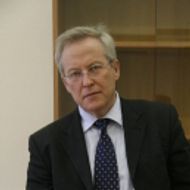- A
- A
- A
- ABC
- ABC
- ABC
- А
- А
- А
- А
- А
- HSE University
- Faculties
- Faculty of World Economy and International Affairs
- School of World Economy
- News
- Modernization in Eurasia through the Prism of the Common Financial Market and Financial Regulation in the EAEU
-
The School
17/1 Malaya Ordynka Str., Moscow, 119017
Phone: +7(495)772-95-90*22237
Email: wec@hse.ru
 The Multilateralism of the New Development Bank on the Sustainable Economic Growth in BRICS Nations and Beyond
The Multilateralism of the New Development Bank on the Sustainable Economic Growth in BRICS Nations and Beyond
Morozkina A., Grigoryev L. M., Gaspardo M. et al.
Emerald Group Publishing Ltd., 2025.
Frontiers in Political Science. 2025. Vol. 7.
Leonid Grigoryev, Morozkina A.
In bk.: The Multilateralism of the New Development Bank on the Sustainable Economic Growth in BRICS Nations and Beyond. Emerald Group Publishing Ltd., 2025. Ch. 6. P. 83-101.
Yakovlev A. A., Freinkman L., Ershova N. V. et al.
QoG Working Paper Series. 2023:19. University of Gothenburg, 2023. No. 19.

Modernization in Eurasia through the Prism of the Common Financial Market and Financial Regulation in the EAEU
Associate professor of the School of World Economy Eduard Dzhagityan presented his research on the topic: “Single banking regulation mechanism as driving force of the EAEU common financial market”.
Integration process in the EAEU requires a more insightful understanding of the role and importance of the regional financial market, its regulation and regulatory institutions for the development and shaping of a single mechanism of economic cooperation. Significant differences in the EAEU member states’ financial markets, along with the policies and standards of banking regulation, do inhibit integration process and may become a source of increased risk during implementation of the integration objectives. The effectiveness of the regulatory mechanism in the EAEU financial area will largely depend on the effectiveness of macro-financial management in improving the stress resilience of banks and the banking sector, minimization of systemic risks, and ensuring financial stability.
On the other side, the actual isolation of the EAEU financial markets from the rest of global financial markets increases the risk of imbalances of the regional financial markets driven by adverse externalities. In this regard, evidence from the Eurozone countries shows that the post-crisis mechanism of international banking regulation (Basel III) mostly lacks of alternative regulatory mechanisms in strengthening the stress resilience of banks and banking sectors and, ultimately, in promoting objectives of economic and financial integration.
The complexity of the EAEU financial sector integration is closely associated with the asymmetries of national regulatory mechanisms and supervisory standards, as well as with the absence of any ready-made remedies underlying regulatory regionalization. The convergence of national regulatory mechanisms followed by their synchronization, both among nations and with the Basel III standards, should form the basis and become the basics of the regional concept of banking regulation (“mini-Basel III”), taking into account that it will include supranational regulatory institutions, to which national regulators will delegate some portion of their power. In this regard, the “mini-Basel III” mechanism should aim at resolution of the Eurasian regulatory trilemma – among the possibilities, relevance, and feasibility of the regional regulatory mechanism, as one of the logical steps towards finalization of the EAEU common financial market framework.
By analyzing the obstacles to the EAEU financial regionalization, the author demonstrates that the imbalances, fragmentation, and weak financial sectors infrastructure in the EAEU member states put extra pressure on banks as lenders of the economy. In this regard, Dr Dzhagityan continued the search for approaches that would resolve the inconsistencies of the integration process through the prism of a single regulatory mechanism in the banking sector. Based on the identified similarities and differences in the banking regulatory mechanisms of the EAEU member states the author assessed the risks of their convergence, which were further detailed in the suggested scenarios for the regionalization of the EAEU banking regulation mechanism.
- About
- About
- Key Figures & Facts
- Sustainability at HSE University
- Faculties & Departments
- International Partnerships
- Faculty & Staff
- HSE Buildings
- HSE University for Persons with Disabilities
- Public Enquiries
- Studies
- Admissions
- Programme Catalogue
- Undergraduate
- Graduate
- Exchange Programmes
- Summer Schools
- Semester in Moscow
- Business Internship
- © HSE University 1993–2025 Contacts Copyright Privacy Policy Site Map
- Edit







